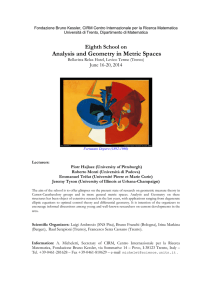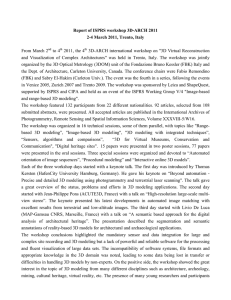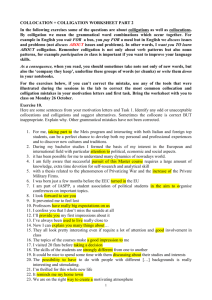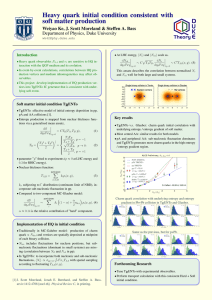Dileptons from quark-gluon plasma (sQGP) Strongly Coupled Edward Shuryak
advertisement
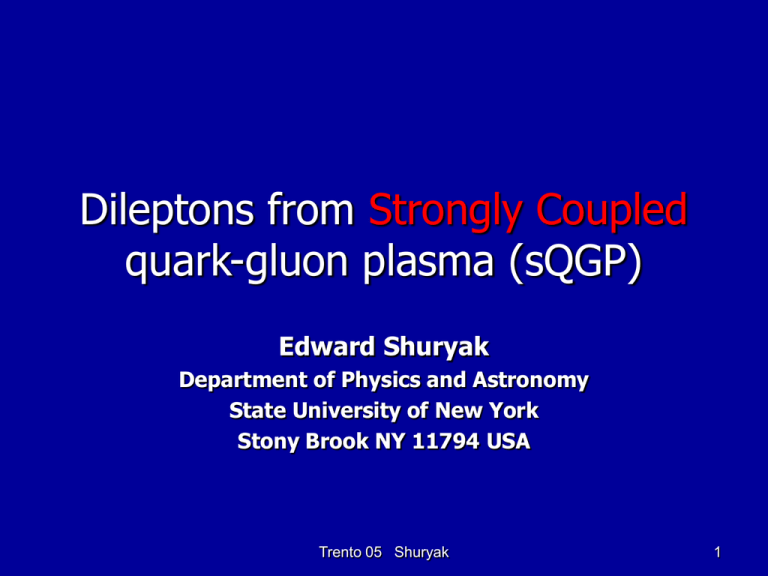
Dileptons from Strongly Coupled quark-gluon plasma (sQGP) Edward Shuryak Department of Physics and Astronomy State University of New York Stony Brook NY 11794 USA Trento 05 Shuryak 1 Background: Motivations: Reduced scale => enhanced coupling Hydro works and QGP seem to have remarkably small viscosity Lattice bound states and large potentials New spectroscopy of sQGP •Multiple bound states, 90% of them colored. If so, it explains several puzzles related to lattice results: •Why resonances in correlators (J/ from MEM)? •How rather heavy quasiparticles can create high pressure already at T= 1.5-2 Tc? Trento 05 Shuryak 2 Outline – main ideas Vectors in QGP and dileptons: Bound states (,,) in L and T forms, and a near-threshold bump can tell us what are the quasiparticle masses and interaction strength in QGP (Jorge Casalderrey +ES) Trento 05 Shuryak Jet quenching due to ``ionization” of new bound states (I.Zahed+ES) 3 Can we verify existence of bound states at T>Tc experimentally? Dileptons from sQGP: an idea M=1.5-2 GeV M=.5-.8 GeV Trento 05 Shuryak 4 Motivation 1: RHIC produces ``matter”, not a fireworks of partons, => hydro and thermodynamics work l << L (the micro scale) << (the macro scale) (the mean free path) << (system size) (relaxation time) << (evolution duration) I •Good equilibration (including strangeness) is seen in particle rations (as at SPS) • the zeroth order in l/L , an ideal hydro, works well (except in hadroic phase) •Viscosity is the O(l/L) effect, » velocity gradients. Note that l» 1/( n) and hydro is (the oldest) strong coupling expansion tool. /s =.1 -.2 Trento 05 Shuryak 5 How strong is strong interaction and where? How large can s be in QGP ? ES,Nucl.Phys.A717:291,2003 In a QCD vacuum the domain of perturbative QCD (pQCD) is limited by non-pert. phenomena, e.g. by the Q> 1 GeV as well as by confinement: so s< 0.3 At high T we get weak coupling because of screening <(gT) << 1 (the Debye mass Md sets the scale) In between, Tc<T<few Tc, there is no chiral/conf. scales While Md=2T= 350-400 MeV is not yet large: can s(Md) be .5-1 (?). If so, binding appears. (ES-Zahed,03) Trento 05 Shuryak 6 T New QCD Phase Diagram, which includes ``zero binding lines” (ES+I.Zahed hepph/030726) The lines marked RHIC and SPS show the adiabatic cooling paths Chemical potential B Trento 05 Shuryak 7 lattice puzzles Since Matsui-Satz and subsequent papers it looked like even J/,c dissolves in QGP (thus it was a QGP signal) And yet recent works (AsakawaHatsuda,Karsch et al) have found, using correlators and MEM, that they survive up to about T=2Tc . What was wrong? Trento 05 Shuryak 8 New ``free energies” for static quarks (from Bielfeld) •Upper figure is normalized at small distances: one can see that there is large ``effective mass” for a static quark at T=Tc. •Both are not yet the potentials! •The lower figure shows the effective coupling constant Trento 05 Shuryak 9 From Bielefld heplat/0406036 •Note that the Debye radius produces ``normal” coupling, but the coeff. is larger •It becomes still larger if V is used instead of F, see later Trento 05 Shuryak 10 For a screened Coulomb potential, a simple condition for a bound state (4/3)s (M/MDebye) > 1.68 M(charm) is large, Md is only about 2T If (Md) indeed runs and is about ½-1, it is large enough to bind charmonium till about T=3Tcor about 500 MeV (which is above the highest T at RHIC) Since q and g quasiparticles are heavy, M appr. 3T, they all got bound as well ! Trento 05 Shuryak 11 Digression: Relativistic eqns have a critical Coulomb coupling for falling onto the center (known since 1920’s) (4/3)s=1/2 is a critical value for Klein-Gordon eqn, at which falling onto the center appears. (It is 1 for Dirac). Trento 05 Shuryak 12 New potentials (cont): after the entropy term is subtracted, potentials become much deeper this is how potential I got look like for T = 1; 1.2; 1.4; 2; 4; 6; 10Tc, from right to left, from ES,Zahed hep-ph/0403127 Trento 05 Shuryak 13 Here is the binding and |psi(0)|^2 Trento 05 Shuryak 14 If a Coulomb coupling is too strong, falling onto the center may occur: but it is still rather difficult to get a binding comparable to the mass But we need massless pion/sigma at T=>Tc ! Brown,Lee,Rho,ES hepph/0312175 : near-local interaction induced by the ``instanton molecules” (also called ``hard glue” or ``epoxy”, as they survive at T>Tc Their contribution is » |(0)|2 which is calculated from strong Coulomb problem Trento 05 Shuryak 15 Solving for the bound states ES+I.Zahed, hep-ph/0403127 In QGP there is no confinement => Hundreds of colored channels may have bound states as well! Trento 05 Shuryak 16 The pressure puzzle (GENERAL) Well known lattice prediction (numerical calculation, lattice QCD, Karsch et al) the pressure as a function of T (normalized to that for free quarks and gluons) •This turned out to be the most misleading picture we had, fooling us for nearly 20 years •p/p(SB)=.8 from about .3 GeV to very large value. Interpreted as an argument that interaction is relatively weak (0.2) and can be resumed, although pQCD series are bad… BUT: we recently learned that storng coupling leads to about 0.8 as well! Trento 05 Shuryak 17 (The pressure puzzle, cont.) How quasiparticles, which according to direct lattice measurements are heavy (Mq,Mg = 3T) (Karsch et al) can provide enough pressure? (exp(-3) is about 1/20) (The same problems appears in N=4 SUSY YM, where it is parametric, exp(-1/2) for large =g2Nc>>1) Trento 05 Shuryak 18 The pressure puzzle is resolved! Trento 05 Shuryak 19 Other observables at T>Tc? Viscosity, charm diffusion coefficient => are binary resonances enough? Chains \bar q g … g q? Succeptibilities at nonzero mu have large peaks (Karsch et al, mu/T^6 paper): => is N bound at T>Tc? Or only diquarks? V.Koch et al: what about <SB>/<S^2>? => (strange B)/(strange B+M) or (qs vs \bar q s bound states)(T) Trento 05 Shuryak 20 Can we verify existence of bound states at T>Tc experimentally? Dileptons from sQGP: Trento 05 Shuryak 21 Quark mass and the interaction strength (“s”) via dileptons Three objects can be seen at nonzero p, T,L bound states (at fixed T<Tz.b.about 2 Tc) and the near-threshold enhancement (``bump”), at any T Why bump? Because attraction between antiq q in QGP enhances annihilation Example: pp(gg) -> t t at Fermilab has a bump near threshold (2mt) due to gluon exchanges. The Gamow parameter for small velocity z= (4/3)s/v; can be > 1, Produces a bump (or jump): the Factor z/(1-exp(-z)) Cancels v in phase space Trento 05 Shuryak 22 a nonrelativistic approach with realistic potentials (Jorge Casalderrey +ES,2004) Trento 05 Shuryak 23 Following the methods developed for t quark Khose and Fadin: sum over states, then Strassler and Peskin: Green function can be formed of 2 solutions We get 2 solutions numerically and checked that published t-pair production for Coulomb is reproduced up to .2 percent! Then we used it for ``realistic” potentials Trento 05 Shuryak 24 Study of near-endpoint annihilation rate using non-rel. Green function, for lattice-based potential (+ instantons) Im(M) for T=1… 2 Tc (a warning: very small width) Trento 05 Shuryak 25 Total width is 20,100 or 200 MeV Trento 05 Shuryak 26 Karsch-Laerman, T=1.5 and 3 Tc Width is not to be trusted ! Asakawa-Hatsuda T=1.4Tc , Trento 05 Shuryak 27 Scattering amplitudes for quasiparticles M. Mannarelli. and R. Rapp hep-ph/05050080 \bar q q scattering no q - gluon scattering yet Trento 05 Shuryak 28 QUARK-HADRON DUALITY AND BUMPS IN QCD: A simple exercise with all M scaling as T (the worse case scenario) Operator product expansion tells us that the integral Under the spectral density should be conserved (Shifman, Vainshtein, Zakharov 78). Three examples which satisfy it (left) the same after realistic time integral Over the expanding fireball (as used in Rapp+ES paper on NA50), divided by a ``standard candle” (massless quarks) (right) Trento 05 Shuryak 29 Summary on dileptons In general, 3*3 objects (for each rho, omega and phi states):L,T vectors plus a near-threshold bump Most observable is probably T=Tc when Vs are about .5-.8 GeV in mass Possibly observable enhancement is in the region 1.5-2 GeV, where 2Mq is about constant in a wide T interval. Not to be present at SPS but at RHIC Realistic potential predicts quite interesting shapes, but the width (and resolution) issue is so far not quite quantitive. Sound waves became narrow in strong coupling: can this mix with omega and produce dileptons? Trento 05 Shuryak 30 Jet quenching by ``ionization” of new bound states in QGP? Trento 05 Shuryak 31 Calculation of the ionization rate ES+Zahed, hep-ph/0406100 Smaller than radiative loss if L>.5-1 fm Is there mostly near the zero binding lines, Thus it is different from both radiative and elastic looses, which are simply proportional to density Relates to non-trivial energy dependence of jet quenching (smaller at 62 and near absent at SPS) Trento 05 Shuryak dE/dx in GeV/fm vs T/Tc for a gluon 15,10,5 GeV. Red-elastic, black -ionization 32 Conclusions: Lattice EoS is about confirmed, Dileptons is a QGP seems to be way to measure the most ideal fluid known masses of qs and /s = .1-.2 the strength of => QGP at RHIC is their in a strong coupling interactions, via regime => New resonances and spectroscopy: many old mesons plus near-threshold hundreds of exotic bumps Trento 05 Shuryak 33 colored binary states Additional slides 34 Sonic boom from quenched jets Casalderrey,ES,Teaney, hep-ph/0410067; H.Stocker… • the energy deposited • • by jets into liquid-like strongly coupled QGP must go into conical shock waves, similar to the well known sonic boom from supersonic planes. We solved relativistic hydrodynamics and got the flow picture If there are start and end points, there are two spheres and a cone tangent to both 35 Distribution of radial velocity v_r (left) and modulus v (right). (note tsunami-like features, a positive and negative parts of the wave) 36 Is such a sonic boom already observed? Mean Cs=.33 time average over 3 stages=> = +/-1.23=1.91,4.37 M.Miller, QM04 37 PHENIX jet pair distribution Note: it is only projection of a cone on phi Note 2: more recent data from STAR find also a minimum in <p_t(\phi)> at 180 degr., with a value Consistent with background 38 Away <pT> vs centrality STAR,Preliminary Away core <pT> drops with centrality faster than corona <pT>. Core hadrons almost identical to medium in central collisions. A punch-thorugh at the highest trigger? 39 away <pT> dependence on angle (STAR,preliminary) Preliminary <pT> (phi) has a dip structure in central AA. 40 Mach shock wave?
